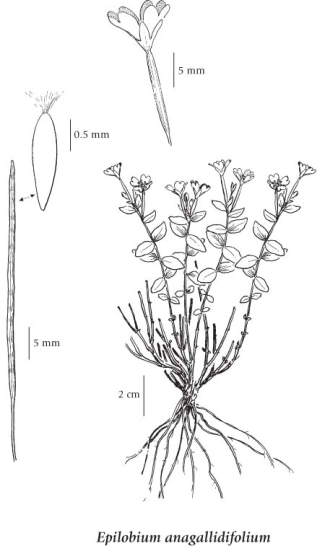Epilobium anagallidifolium Lam.
alpine willowherb (pimpernel willowherb)
Onagraceae (Evening Primrose family)
Introduction to Vascular Plants
alpine willowherb (pimpernel willowherb)
Onagraceae (Evening Primrose family)
Introduction to Vascular Plants
Map
Distribution of Epilobium anagallidifolium
Click here to view the full interactive map and legend
Species Information
General:
Perennial herb from a fibrous root, tufted, somewhat mat-forming, with short stolons; stems ascending to erect, somewhat curved or S-shaped, 10-20 cm tall, green or reddish-tinged, sparsely short stiff-hairy in decurrent lines below, with some glandular hairs above, often with basal offshoots.
Leaves:
Opposite, narrowly elliptic to oblong or oblanceolate, 0.8-2.5 cm long, 2-9 mm wide, rounded at tips, entire to finely few-toothed, dark green or reddish-tinged, basal glabrous, upper sparsely short stiff-hairy on midrib and leaf margins; stalks obscure, 1-6 mm long.
Flowers:
Inflorescence a few-flowered, terminal raceme, often nodding; hypanthium 0.6-1.4 mm long; petals 2.5-6.5 (9) mm long, pink to rose-purple, rarely white, notched at tip; sepals 1.5-5 mm long, glabrous or sparsely glandular; anthers 0.3-0.6 mm long; ovaries 0.6-2 cm long, glabrous; styles 1.2-2.5 mm long; stigmas broadly club-shaped, rarely somewhat head-like.
Fruits:
Capsules, 1.7-3.6 cm long, about 1 mm wide, curved, nearly glabrous, red when ripe; seeds narrowly egg-shaped, 0.7-1.4 mm long, surface mostly net-veined, tuft of soft hairs persistent, 1.5-4 mm long, dull white.
Illustration

If more than one illustration is available for a species (e.g., separate illustrations were provided for two subspecies) then links to the separate images will be provided below. Note that individual subspecies or varietal illustrations are not always available.
Illustration Source: The Illustrated Flora of British Columbia
Ecology
Ecological Framework for Epilobium anagallidifolium
The table below shows the species-specific information calculated from
original data (BEC database) provided by the BC Ministry of Forests and Range.
(Updated August, 2013)
The table below shows the species-specific information calculated from
original data (BEC database) provided by the BC Ministry of Forests and Range.
(Updated August, 2013)
| Site Information |
Value / Class |
||
|
Avg |
Min |
Max |
|
| Elevation
(metres) |
1752 | 20 | 2563 |
| Slope
Gradient (%) |
25 | 0 | 125 |
|
Aspect (degrees) |
204 | 0 | 360 |
| Soil
Moisture Regime (SMR) [0 - very xeric; 4 - mesic; 8 - hydric] |
4 | 0 | 8 |
| Modal
Nutrient Regime
Class |
D | ||
| #
of field plots species was recorded in: |
591 | ||
| Modal
BEC Zone Class |
ESSF | ||
|
All BEC Zones (# of stations/zone) species was recorded in |
AT(32), BAFA(73), BWBS(2), CMA(12), CWH(7), ESSF(310), ICH(11), IDF(6), IMA(17), MH(30), MS(14), SBPS(1), SBS(18), SWB(8) | ||
|
Source:
Klinkenberg 2013
|
|||
Habitat and Range
Mesic to wet mossy or rocky slopes, streambanks, gravel bars, seepage areas and open meadows in all vegetation zones; rare at low elevations, common at higher elevations throughout BC, especially northward; circumboreal, N to AK, YT and NT, E to NF, S to CA, CO and ME; Eurasia.Status Information
Synonyms
Synonyms and Alternate Names:
Epilobium alpinum L. p.p.
Epilobium anagallidifolium var. pseudoscaposum (Hausskn.) HultTn